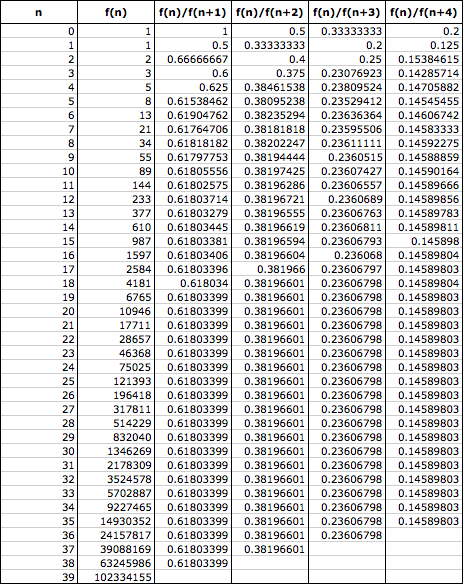

Assignment 12
by
Allison McNeece
For this assignment we will be using EXCEL spreadsheets to explore the Fibonnaci sequence.
Part A |
|---|
Construct the ratio of each pair of adjacent terms in the Fibonnaci sequence. What happens as n increases? What about the ratio of every second term? etc. |
The table to the right was constructed using Excel. The first column is our values for n. The second column is the Fibonnaci sequence: f(n) = f(n)+f(n+1), given f(0)=1 and f(1)=1 The third column is the ratio of the adjacent terms of the Fibonnaci sequence. Notice that this sequence appears to have a limit and n goes to infinity. (That is to say, the terms are getting closer and closer to being the same number as n gets larger and larger) Can we prove it? The fourth column is the ratio of every other term in the Fibonnaci sequence. This sequence also seems to converge. The fifth column is the sequence of the ratio of every third term in the Fibonnaci sequence. Does this sequence also have a limit? Finally the sixth column is the ratio of every fourth term in the Fibonnaci sequence. Does this sequence have a limit? Is it possible that the sequence of f(n)/f(n+k) will have a limit for any positive integer k? How would we prove it?
|
 |
|---|
Part B |
|---|
Explore sequences where f(0) and f(1) are some arbitrary integers other than 1. If f(0)=1 and f(1)=3, then your sequence is a Lucas Sequence. All such sequences, however, have the same limit of the ratio in successive terms. |
The table to the right is the Lucas sequence. It is formed in the same way as the Fibonnaci sequence but with starting terms of f(0)=1 and f(1)=3 The columns are set up in the same way as the previous table. Column one is our values of n. Column two is our values for f(n). Column three the ratio of adjacent terms. Column four the ratio of every other term. Column five the ratio of every third term. Column six the ratio of every fourth term. Notice how these sequences also appear to have limits. How do these limits compare to the limits found using the Fibonacci sequence? How would we compare these limits in general terms?
|
 |
|---|
Here is a link to the Excel spreadsheet used for this assignment if you wish to play around with the numbers yourself.